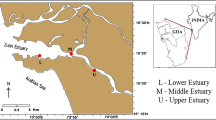Abstract
Bioaccumulation of trace metals in four soft-bottom polychaetes along with the host sediments was recorded from the intertidal regions of Indian Sundarban mangrove wetland. The enrichment of Mn (maximum 730 mg kg−1) and Zn (maximum 320 mg kg−1) was recorded for all the polychaetes followed by Cr, Cu, As, Co, Ni and Pb, showing sharp variations between the species. However, concentrations of Sn and Hg were very low with small variations between the species. An overall high bioconcentration factor (BCF) was recorded in the capitellid worm Mastobranchus indicus. The results of the investigation indicate the possibility of developing a standard test protocol for bioaccumulation by polychaetous annelids.
Similar content being viewed by others
References
Amiard JC, Triquet C, Berthet B, Metayer C (1987) Comparative study of the patterns of bioaccumulation of essential (Cu, Zn) and non-essential (Cd, Pb) trace metals in various estuarine and coastal organisms. J Exp Mar Biol Ecol 106:73–89
Bryan GW, Langston WJ (1992) Bioavailability, accumulation and effects of heavy metals in sediments with special reference to United Kingdom estuaries: a review. Environ Poll 76:89–131
Casado-Martinez MC, Smith BD, Luoma SN, Rainbow PS (2010) Bioaccumulation of arsenic from water and sediment by a deposit feeding polychaetes (Arenicola marina): a biodynamic modeling approach. Aquat Toxicol 98:34–43
Cousins RJ (1985) Absorption, transport and hepatic metabolism of copper and zinc special reference to metallothionein and ceruloplasmin. Physiol Rev 65:238–309
Depledge MH, Rainbow PS (1990) Models of regulation and accumulation of trace metals in marine invertebrates. Comp Biochem Physiol Comp Pharmacol 97:1–7
Fernandes C, Nhas-Fernandes AF, Peixotoc F, Salgado MA (2007) Bioaccumulation of heavy metals in Liza saliens from the Esmoriz-Paramos coastal Lagoon, Portugal. Ecotoxicol Environ Safety 66:426–431
Folk RL, Ward WC (1957) Brazos river bar: a study in the significance of grain size parameter. Sediment Petrol J 27:3–26
Foster HD (2004) How HIV-1 causes AIDS: implications for prevention and treatment. Med Hypoth 62:549–553
Friedman GM, Sanders JE (1978) Principles of sedimentology. Wiley, London, p 792
Ganeev AA, Pogarev SE, Ryzhov VV, Sholupov SE, Dreval TV (1995) The new method for direct and express determination of mercury in oil, gas condensate, and biological samples. Ecol Chem (Russia) 4:122–126
Gibbs PE, Bryan GW, Ryan KP (1981) Copper accumulation by the polychaetes Melinna palmata: an antipredation mechanism? J Mar Biol Assoc UK 61:707–722
Gibbs PE, Langston WJ, Burt GR, Pascoe PL (1983) Tharyx marioni (Polychaeta): a remarkable accumulator of arsenic. J Mar Biol Assoc UK 63:313–325
Hutchings P (1998) Biodiversity and functioning of polychaetes in benthic sediments. Biodivers Conserv 7:1133–1145
Kehrig HA, Malm O, Moreira I (1998) Mercury in widely consumed fish Micropogonias furnieri (Demarest 1823) from four main Brazilian estuaries. Sci Total Environ 213:263–271
Krumbein WC, Pettijohn FJ (1938) Manual of sedimentary petrology. Plenum, New York, p 549
Liao JF (1990) The chemical properties of the mangrove Solonchak in the northeast part of Hainan Island. Acta Scient Natur Univ Sunyatseni (Suppl) 9:67–72
Mahler HR (1956) Nature and functions of metalloflavoproteins. Adv Enzymol 17:233
Moody JR, Lindstrom RM (1977) Selection and cleaning of plastic container for storage of trace element samples. Analyt Chem 49:2264–2267
Mouneyrac C, Mastain O, Amiard JC, Amiard-Triquet C, Beaunier P, Jeantet AY, Smith BD, Rainbow PS (2003) Trace-metal detoxification and tolerance of the estuarine worm Hediste diversicolor chronically exposed in their environment. Mar Biol 143:731–744
Olsgard F, Somerfield PJ (2000) Surrogates in marine benthic investigations–which taxonomic unit to target? J Aquat Ecosys Stress Recovery 7:25–42
Rainbow PS (1995) Physiology, physicochemistry and metal uptake–A crustacean perspective. Mar Pollut Bull 31:55–59
Saha M, Sarkar SK, Bhattacharya B (2006) Interspecific variation in heavy metal body concentrations in biota of Sundarban mangrove wetland, northeast India. Environ Int 32:203–207
Sarkar SK, Bhattacharya A, Giri S, Bhattacharya B, Sarkar D, Nayak DC, Chattopadhaya AK (2005) Spatiotemporal variation in benthic polychaetes (Annelida) and relationship with environmental variables in a tropical estuary. Wetl Ecol Manag 13:55–67
Sato M, Nakashima A (2003) A review of Asian Hediste species complex (Nereididae, Polychaeta) with descriptions of two new species and a redescription of Hediste japonica (Izuka, 1908). Zool J Linn Soc 137:403–445
Simpson RD (1979) Uptake and loss of zinc and lead by mussels (Mytilus edulis) and relationship with body weight and reproductive cycle. Mar Pollut Bull 10:74–78
Sun F, Zhou Q (2007) Metal accumulation in the polychaete Hediste japonica with emphasis on interaction between heavy metals and petroleum hydrocarbons. Environ Poll 149:92–98
Walkey A, Black TA (1934) An examination of the dugtijaraff method for determining soil organic matter and proposed modification of the chronic and titration method. Soil Sci 37:23–38
Zhou QX, Kong FX, Zhu L (2004) Ecotoxicology: principles and methods. Science Press, Beijing, pp 161–217
Acknowledgments
The research work was supported by University Grants Commission (UGC), New Delhi, India [(Sanction No UGC/199/UPE/07] under the scheme of “University with Potential for Excellence” (Modern Biology Group). One of the authors (Md. A. Alam) is greatly indebted to UGC for awarding him project fellowship.
Author information
Authors and Affiliations
Corresponding author
Rights and permissions
About this article
Cite this article
Alam, M.A., Gomes, A., Sarkar, S.K. et al. Trace Metal Bioaccumulation by Soft-bottom Polychaetes (Annelida) of Sundarban Mangrove Wetland, India and Their Potential Use as Contamination Indicator. Bull Environ Contam Toxicol 85, 492–496 (2010). https://doi.org/10.1007/s00128-010-0110-1
Received:
Accepted:
Published:
Issue Date:
DOI: https://doi.org/10.1007/s00128-010-0110-1




